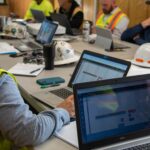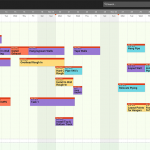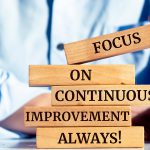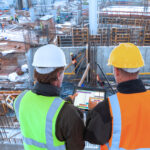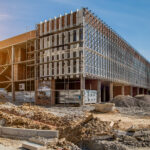Tom Richert, a Principal with Lean Project Consulting, dropped by Touchplan last week for a conversation about his new book, Lean Conversations: The Energy of the Creative Ethos in Your Life and Work. The book presents the findings of a workshop Richert designed to introduce a group of professionals from a variety of artistic fields to Lean methodology, and to learn more about their perspective. Our conversation has been condensed and slightly edited.
Katherine Van Adzin: To start off, how did you get the idea for a workshop focused on the artist’s perspective?
Tom Richert: Well, at Lean Project Consulting, we do a lot of work with language-action perspective as part of the Last Planner® System and as part of helping companies and individuals make commitments to each other. And an aspect of that is that our understanding of work comes from the language that we use. And that’s lead me also to read some works by Charles Taylor. From that reading and from that aspect of understanding Lean work, it started to occur to me that Lean has been interpreted largely by people with engineering and social science backgrounds, and it’s been presented to people as this scientific approach to work, learning and continuous improvement.
So, I wondered about people who had a different framework in terms of how they thought about their work. And I wondered, what would the artist’s perspective be?
KV: What would you say was the most surprising or illuminating thing that arose during the workshop?
TR: It was the third insight of the book, that Lean is practice without a language. And at the time, it was surprising because how many words do we have? Two languages, a third if you throw in Takt time. So, it was, “What do you mean?”
And even since that was written, I’ve reflected on the issue of Lean being not universally accepted as something even worth investigating. In considering why people don’t buy into it and why don’t they sustain it, and realizing one reason is the language isn’t compelling to a lot of people. And you see the people that grasp it quicker have a process orientation and background, so I do think they fill in the blanks, if you will. So, the language of Lean right now is sort of like a shorthand that some people get and most people don’t.
KV: What do you think could be done to change that? Have you been thinking about that since the workshop?
TR: Yes, I think a lot of what’s missing is how do the practices of Lean connect people to what their work is and what their personal natures and interests are? And there’s work to do on what might be called the “social aspects” of understanding why a continuous improvement mindset is personally beneficial to people and helps them achieve whatever it is that they want to in terms of their nature. We use the term “core identity” for describing this nature. Core personal identity for an individual and core shared identity for a team.
So, people need to focus on these practices and then we can develop language that is a little more approachable for people.
KV: One thing I’ve noticed in construction is that people will say, “Oh yeah, on this project, we’re doing Lean.” Lean is the activity. How do you get around that mindset of Lean as an imposed activity?
TR: Yes. You need to stress that these are practices that are intended to help you improve and grow. And in construction and design and actually in industry, that’s not done universally very well. The purpose of Lean has been expressed as, in construction, “We’re gonna build this building faster and we’re going to build for less money.”
Those are outcomes that are helpful because they help fuel the growth that we want to promote in people. And they also allow for better and more healthcare facilities, better and more housing, better and more museums. So, there are a lot of benefits to Lean that are results, but I if the focus were understood to be more about growth of individuals and work as a mechanism for that growth, it would be more accepted.
So yes, you don’t “do” Lean, you’re either committed to growing and being excellent in a path that you choose, and probably if you’re in construction or design you are on a path that somehow relates to that. But what gets lost sometimes is that with all of the other demands and the labels that get put on people, they forget why they even got into that industry to begin with. And then you don’t feel like doing what you need to get better, to grow—you just feel like getting through the day the best you can.
KV: And I’m sure when that’s the case you probably don’t see the same outcomes.
TR: Oh, you see resistance, you do. You can put together a percent plan complete (PPC) chart, without ever really doing anything there. You can go through the motions of the Last Planner® System without really grasping and understanding and getting the benefit of what the Lean approach is.
Now, fortunately, we get to work with people that are more on the end of really embracing it and wanting to be pushed. When we go in coaching, we’re trying to help them get basic fundamentals down and then as they do that we’re asking, “Can we push you?” And most people say, “Yeah. We want to do this better. We want to get better.”
KV: Do you think that anything about your approach in your consulting work has changed following the workshop?
TR: Yes. Starting to focus more on having conversations about what people are doing, why they’re in the industry, and how does that line up with their purpose? This whole idea of buy-in and sustaining Lean effort is of concern to a lot of clients, and ideally, we would start to do more work around this issue in these early workshops and focus on connecting people to purpose.
KV: What implications do you think the findings of the workshop could have for the way work is performed in construction?
TR: I think that’s where the idea of purpose is really important. People do need that kind of purpose to have the energy to drive forward. So, there’s more focus on just helping people understand that.
I once saw a really good example of that. Cleveland Clinic does a really good job in general about mixing the science of medicine with the emotional aspects of caregiving. And for the Taussig Cancer Center they built—we were fortunate to coach the teams there—one of the things they did is show people that were working on the project a video that explained what this project means, and what it means to have cancer and to be treated and the importance of this project.
For example, they had a bulletin board where workers could put notes or anything they wanted to about people in their lives who have had cancer, or about themselves if they were cancer survivors. So, you create this real emotional connection between the people on the project and the reason for that project. And in terms of Lean work, there were a lot of successes on that project. There were a lot of good things that team achieved and I believe people understanding the purpose of the work was a big part of that.
KV: When you focus on the construction industry, what do you think are the biggest barriers to Lean?
TR: I think there are a few, maybe some are somewhat related. One is the tradition of the superintendent on the project site being central to everything that happens. It has some superintendents reluctant to let go of those reins. They don’t recognize that their real value to the project has been their ability to lead teams and lead people. And if they focused on that, the Last Planner® and the Lean approach lets them do an even better job of that.
I think another barrier is understanding that it really is about continuous improvement. People aren’t yet excited about pushing the envelope. And that’s where we think bringing in this novel concept of understanding who you are and why that relates to purpose might pull people closer to that.
And there are some structural issues that keep us from being even better in terms of carpenters only do certain work, electricians only do certain work, plumbers only do certain work, and so on. That’s a challenge if you’re a worker. Because of the over-specialization in the industry you get shuffled from project to project and there’s a whole new commute, there’s a whole new set of people you’re working with…emotionally, and intellectually, too, that’s somewhat challenging. So, the more stability you can provide somebody in this industry, the better off workers will be.
KV: When you look at implementing Lean in construction, do you think that some of the alternative project delivery methods like design-build or integrated project delivery help facilitate things?
TR: Well, integrated project delivery clearly does. There’s a team that just opened a building that I’ve been coaching and there just was a world of difference compared to other projects. They would all say they would all want to do only integrated project delivery projects if they could and work with the integrated forms of agreement because the personal atmosphere was tremendous. They had the ability to take nearly 10 million dollars out of a project that had a 30-million-dollar budget. The client wanted a lot, and they were able to work together and actually achieve that in a fun work environment.
With design-build, you can work in a more integrated way, but it’s an older format. It doesn’t necessarily automatically facilitate it.
KV: What else do you think is changing in construction, industry-wise?
TR: It’s been around a while now, but the integrated form of agreement—the more that those are done, I think that can be helpful in construction. I see more—in the last several years—emphasis on the social aspects of working together as a team. That’s helpful.
KV: And in terms of design?
TR: Well, certainly there’s this whole conversation about what’s the best way to use Last Planner® in design or can you even use Last Planner® in design because design is iterative. Which, at a certain point it really is, but at a certain point what they’re calling iterations are rework. So, I’m working with a client right now that is, from a design process perspective, doing some really good work because they’re being very defined about the stages that their work needs to progress through.
So, each stage of the design is an iteration, but when the iteration is complete, you move on to the next stage. And this firm is doing that, and I think if more firms could embrace that, then you could see it’s still a Last Planner®-type approach.
Then the other new ground to break that’s rich with possibility is how do we use some of these Lean process design concepts like set-based design in architectural design? Now, it’s used, but on such a really limited basis. There is much architects can learn from Lean product and process designers.
What’s missing, or what the Lean product and process design people could learn from architects, is how to approach a design challenge that is so much more complex and so much richer than a lot of product design challenges, in terms of what they’re concerned about—mood, experiences of people, the functionality of people working in a space, how the space appears, how an interior space works, how the exterior space works, how the building visually works on its own but also in the context of the neighborhood. And then there are the different users of a building, facilities, caretakers of a building.
KV: In terms of other broader industry changes, how do you see technology impacting construction?
TR: I think to a degree, technology can help people leverage time. Technology can help improve communications, clarify communications—and when technology is used to help with the conversations, define better what work should be done and clarify what commitment should be made. So, when technology is used that way, it can facilitate a shared understanding of the work to be accomplished. In fact, it can help structure that. Because that’s what Last Planner® is, it’s a structure for having conversations.
And I think it can also help people think in more detail. There’s a tendency, still even with Last Planner®, for people to be a little bit vague, a little bit more general, about what their intentions are and what they’re committing to. And so, I think technology has the possibility of shaping those conversations in a more productive way.
The ability to convey information to more places is another important role. It’s nice that you can have the work plan on your iPad if it’s kept electronically. And it’s consistent from one person to another. So, I think technology could facilitate a richer Lean experience when people use it to have richer conversations.
Click here to learn more about how to use Touchplan to improve your Lean experience and have more productive planning conversations.
